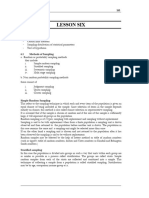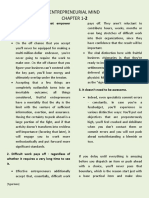0 ratings0% found this document useful (0 votes)
16 viewsLesson Review - Sampling and Sampling Distributions
This document provides a chapter review that covers key concepts and formulas related to sampling plans, experimental designs, statistics, sampling distributions, and statistical process control. It defines different sampling methods like simple random sampling, stratified random sampling, and cluster sampling. It also covers the central limit theorem, sampling distributions of the sample mean and proportion, and how to monitor processes using x-charts and p-charts.
Uploaded by
SLPCopyright
© © All Rights Reserved
Available Formats
Download as PDF, TXT or read online on Scribd
0 ratings0% found this document useful (0 votes)
16 viewsLesson Review - Sampling and Sampling Distributions
This document provides a chapter review that covers key concepts and formulas related to sampling plans, experimental designs, statistics, sampling distributions, and statistical process control. It defines different sampling methods like simple random sampling, stratified random sampling, and cluster sampling. It also covers the central limit theorem, sampling distributions of the sample mean and proportion, and how to monitor processes using x-charts and p-charts.
Uploaded by
SLPCopyright
© © All Rights Reserved
Available Formats
Download as PDF, TXT or read online on Scribd
You are on page 1/ 1
CHAPTER REVIEW ❍ 287
CHAPTER REVIEW
Key Concepts and Formulas
I. Sampling Plans and Experimental 3. Probabilities involving the sample mean can
Designs be calculated by standardizing the value of
1. Simple random sampling !x using z:
a. Each possible sample of size n is equally x! $ m
likely to occur. z"# #
s/"n!
b. Use a computer or a table of random num-
bers. IV. Sampling Distribution of the Sample
c. Problems are nonresponse, undercoverage, Proportion
and wording bias. 1. When samples of size n are drawn from a bino-
2. Other sampling plans involving randomization mial population with parameter p, the sample
proportion p̂ will have an approximately normal
a. Stratified random sampling
distribution with mean p and standard deviation
b. Cluster sampling ! as long as np % 5 and nq % 5.
"pq/n
c. Systematic 1-in-k sampling 2. Probabilities involving the sample proportion
3. Nonrandom sampling can be calculated by standardizing the value p̂
a. Convenience sampling using z:
b. Judgment sampling p̂ $ p
z" #
c. Quota sampling pq
II. Statistics and Sampling Distributions
#$
##
n
1. Sampling distributions describe the possible V. Statistical Process Control
values of a statistic and how often they occur 1. To monitor a quantitative process, use an !x
in repeated sampling. chart. Select k samples of size n and calculate
2. Sampling distributions can be derived mathe- the overall mean x!! and the standard deviation s
matically, approximated empirically, or found of all nk measurements. Create upper and lower
using statistical theorems. control limits as
3. The Central Limit Theorem states that sums s
and averages of measurements from a nonnor- !!x & 3##
mal population with finite mean m and stan- "!n
dard deviation s have approximately normal
If a sample mean exceeds these limits, the pro-
distributions for large samples of size n.
cess is out of control.
III. Sampling Distribution of the Sample 2. To monitor a binomial process, use a p chart.
Mean Select k samples of size n and calculate the
1. When samples of size n are randomly drawn average of the sample proportions as
from a normal population with mean m and
variance s 2, the sample mean x! has a normal S p̂
p! " ##i
distribution with mean m and standard devia- k
tion s/"n !.
Create upper and lower control limits as
2. When samples of size n are randomly drawn
from a nonnormal population with mean m and p!(1 $ p!)
variance s 2, the Central Limit Theorem ensures #$$
!p & 3 #n#
that the sample mean x! will have an approxi-
mately normal distribution with mean m and stan- If a sample proportion exceeds these limits, the
dard deviation s/"n ! when n is large (n ! 30). process is out of control.
You might also like
- Hourglass Workout Program by Luisagiuliet 276% (21)Hourglass Workout Program by Luisagiuliet 251 pages
- The Hold Me Tight Workbook - Dr. Sue Johnson100% (16)The Hold Me Tight Workbook - Dr. Sue Johnson187 pages
- Read People Like A Book by Patrick King-Edited62% (66)Read People Like A Book by Patrick King-Edited12 pages
- Livingood, Blake - Livingood Daily Your 21-Day Guide To Experience Real Health77% (13)Livingood, Blake - Livingood Daily Your 21-Day Guide To Experience Real Health260 pages
- COSMIC CONSCIOUSNESS OF HUMANITY - PROBLEMS OF NEW COSMOGONY (V.P.Kaznacheev,. Л. V. Trofimov.)94% (212)COSMIC CONSCIOUSNESS OF HUMANITY - PROBLEMS OF NEW COSMOGONY (V.P.Kaznacheev,. Л. V. Trofimov.)212 pages
- Donald Trump & Jeffrey Epstein Rape Lawsuit and Affidavits83% (1016)Donald Trump & Jeffrey Epstein Rape Lawsuit and Affidavits13 pages
- The 36 Questions That Lead To Love - The New York Times94% (34)The 36 Questions That Lead To Love - The New York Times3 pages
- The 36 Questions That Lead To Love - The New York Times95% (21)The 36 Questions That Lead To Love - The New York Times3 pages
- Jeffrey Epstein39s Little Black Book Unredacted PDF75% (12)Jeffrey Epstein39s Little Black Book Unredacted PDF95 pages
- The 4 Hour Workweek, Expanded and Updated by Timothy Ferriss - Excerpt23% (954)The 4 Hour Workweek, Expanded and Updated by Timothy Ferriss - Excerpt38 pages
- Silverman, Marvasti - Doing Qualitative Research (A Comprenhesive Guide) (2008) PDFNo ratings yetSilverman, Marvasti - Doing Qualitative Research (A Comprenhesive Guide) (2008) PDF286 pages
- #1 Technopreneurs and The Technology Evolution - Nicochelle100% (1)#1 Technopreneurs and The Technology Evolution - Nicochelle3 pages
- Sampling Distribution: Standard Deviation) Computed For Each Possible Sample That Could Be Drawn From The Target100% (1)Sampling Distribution: Standard Deviation) Computed For Each Possible Sample That Could Be Drawn From The Target4 pages
- 9 Sampling Distribution and Point Estimation of ParametersNo ratings yet9 Sampling Distribution and Point Estimation of Parameters4 pages
- SAMPLING-DISTRIBUTION-AND-POINT-ESTIMATENo ratings yetSAMPLING-DISTRIBUTION-AND-POINT-ESTIMATE3 pages
- Chapter 3 Sampling Distribution and Confidence Interval100% (2)Chapter 3 Sampling Distribution and Confidence Interval57 pages
- Chapter 3 - Sampling Distribution and Confidence Interval1No ratings yetChapter 3 - Sampling Distribution and Confidence Interval154 pages
- Introduction To Sampling Distributions Unit 2D: SECTION K: Chapter 64 of John Bird Textbook Compiled by T Motsima 2021No ratings yetIntroduction To Sampling Distributions Unit 2D: SECTION K: Chapter 64 of John Bird Textbook Compiled by T Motsima 202130 pages
- Chapter Two Fundamentals of Marketing Estimation and Hypothesis TestingNo ratings yetChapter Two Fundamentals of Marketing Estimation and Hypothesis Testing73 pages
- Statistics For Management Unit 2 2 MarksNo ratings yetStatistics For Management Unit 2 2 Marks3 pages
- Lesson 9 Sampling Distribution of Sample MeansNo ratings yetLesson 9 Sampling Distribution of Sample Means18 pages
- PSUnit III Lesson 1 Sampling Distribution of Sample MeansNo ratings yetPSUnit III Lesson 1 Sampling Distribution of Sample Means18 pages
- PSUnit III Lesson 2 Finding The Mean - and Variance of The Sampling Distribution of MeansNo ratings yetPSUnit III Lesson 2 Finding The Mean - and Variance of The Sampling Distribution of Means21 pages
- Chapter 7 Confidence Interval and Sample Mean ANo ratings yetChapter 7 Confidence Interval and Sample Mean A37 pages
- PSUnit III Lesson 1 Sampling Distribution of Sample MeansNo ratings yetPSUnit III Lesson 1 Sampling Distribution of Sample Means17 pages
- Sampling Distributions of Sample Means and Proportions PDFNo ratings yetSampling Distributions of Sample Means and Proportions PDF14 pages
- Analytical Chemistry: Course Tutor: Dr. Kashif Gul Course: Special Topics in Analytical ChemistryNo ratings yetAnalytical Chemistry: Course Tutor: Dr. Kashif Gul Course: Special Topics in Analytical Chemistry37 pages
- Lecture 03 Probability and Statistics Review Part2No ratings yetLecture 03 Probability and Statistics Review Part274 pages
- Learn Statistics Fast: A Simplified Detailed Version for StudentsFrom EverandLearn Statistics Fast: A Simplified Detailed Version for StudentsNo ratings yet
- Types of Organisational Structures: Their Advantages and Disadvantages!No ratings yetTypes of Organisational Structures: Their Advantages and Disadvantages!16 pages
- 14.740x: Foundations of Development Policy: IntructorsNo ratings yet14.740x: Foundations of Development Policy: Intructors10 pages
- Is Soil Quality A Concern in Sugarcane Cultivation PDFNo ratings yetIs Soil Quality A Concern in Sugarcane Cultivation PDF8 pages
- Download Statistics for Nursing Research A Workbook for Evidence-Based Practice 3rd Edition Susan K. Grove ebook All Chapters PDF100% (5)Download Statistics for Nursing Research A Workbook for Evidence-Based Practice 3rd Edition Susan K. Grove ebook All Chapters PDF37 pages
- 1 Self-Efficacy and Health Behavior TheoriesNo ratings yet1 Self-Efficacy and Health Behavior Theories4 pages
- King Fahd University of Petroleum & Minerals (Kfupm) Deanship of Graduate Studies Dhahran, Saudi ArabiaNo ratings yetKing Fahd University of Petroleum & Minerals (Kfupm) Deanship of Graduate Studies Dhahran, Saudi Arabia5 pages
- How To Make Chapter 1 in Thesis - Google PangitaNo ratings yetHow To Make Chapter 1 in Thesis - Google Pangita1 page
- What Is Emotional Intelligence?: EssentialsNo ratings yetWhat Is Emotional Intelligence?: Essentials2 pages
- A Review of Energy and Power Planning and Policies of PakistanNo ratings yetA Review of Energy and Power Planning and Policies of Pakistan19 pages
- Boresight Calibration of Mobile Mapping SystemsNo ratings yetBoresight Calibration of Mobile Mapping Systems10 pages
- DRDO Entry Test: Defence Research & Development Organisation (DRDO)No ratings yetDRDO Entry Test: Defence Research & Development Organisation (DRDO)2 pages
- Entrepreneurial Mind Chapter 1-2: Beliefs and Assumptions That Empower Entrepreneurs 1. The Sky Is The LimitNo ratings yetEntrepreneurial Mind Chapter 1-2: Beliefs and Assumptions That Empower Entrepreneurs 1. The Sky Is The Limit12 pages























































































































